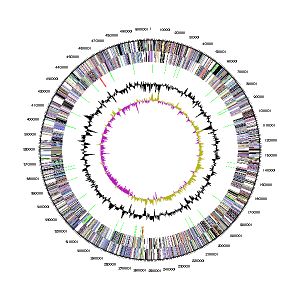Candidatus Accumulibacter Phosphatis: Difference between revisions
| Line 33: | Line 33: | ||
[[File:Map_of_Candidatus_Accumulibacter_Phosphates_Clade_IIA_Chromosome.jpg|thumb|''Map of Candidatus Accumulibacter Phosphates Clade IIA Chromosome'']] | [[File:Map_of_Candidatus_Accumulibacter_Phosphates_Clade_IIA_Chromosome.jpg|thumb|''Map of Candidatus Accumulibacter Phosphates Clade IIA Chromosome'']] | ||
The "Accumulibacter" Genome consists of one circular chromosome and three plasmids. | The "Accumulibacter" Genome consists of one circular chromosome and three plasmids. | ||
The size of this genome is 5306133 base pairs coding for 4790 genes. 3.82% of the "Accumulibacter phosphatis" genome is unlike all other organisms relating to both sequence similarity and function. | |||
Describe the size and content of the genome. How many chromosomes? Circular or linear? Other interesting features? What is known about its sequence? | Describe the size and content of the genome. How many chromosomes? Circular or linear? Other interesting features? What is known about its sequence? | ||
Revision as of 15:48, 22 April 2010
PAGE UNDER CONSTRUCTION
Classification
Kingdom: Bacteria
Phylum: Proteobacteria
Class: Betaproteobacteria
Order: unclassified Betaproteobacteria
Family: Candidatus Accumulibacter
Species
Candidatus Accumulibacter phosphatis
NCBI Taxonomy ID: 522306 Sub Groups:
Description and Significance
Describe the appearance, habitat, etc. of the organism, and why you think it is important. "Candidatus Accumulibacter phosphatis" is of the group of organisms know as polyphosphate-accumulating organisms (PAO).
This organism is used in waste water treatment for the purpose of enhanced biological phosphorus removal (EBPR)(Lu). Waste water effluent can be a major contributor of phosphorous pollution to the environment, which can cause excess nutrient loading that leads to algal blooms. Traditional methods of Phosphorous removal include chemical remobal process and EBPR. Advantages of operating a waste water treatment plant with EBPR are that it significantly lowers operating costs, reduces sludge production and enables sludege to be reused easier, and eliminates chemical biproducts (Blackall, 2002).
Genome Structure
The "Accumulibacter" Genome consists of one circular chromosome and three plasmids. The size of this genome is 5306133 base pairs coding for 4790 genes. 3.82% of the "Accumulibacter phosphatis" genome is unlike all other organisms relating to both sequence similarity and function.
Describe the size and content of the genome. How many chromosomes? Circular or linear? Other interesting features? What is known about its sequence?
NCBI Mapped Genome Online genome information
Cell Structure, Metabolism and Life Cycle
Metabolism
Interesting features of cell structure; how it gains energy; what important molecules it produces.
"Accumulibacter" is a chemo heterotroph and can exist in both aerobic and anaerobic conditions.
Aerobic Conditions
Under aerobic conditions "Accumulibacter" uptakes orthophosphate from the environment and stores it as polyphosphate.
Anaerobic Conditions
Under anaerobic conditions "Accumulibacter" uptakes volatile fatty acids (VFAs) and stores the carbon as polyhydroxyalkanoates (PHAs) as it's anabolic pathway. Energy is generated in part by glycolysis throught the reduction of glycogen and also through the hydrolysis of stored polyphosphate to orthophosphate which is released into the environment (Pijuan 2003).
Ecology and Pathogenesis
Habitat; symbiosis; biogeochemical significance; contributions to environment. If relevant, how does this organism cause disease? Human, animal, plant hosts? Virulence factors, as well as patient symptoms.
Candidatus Accumulibacter Phosphatis is a type of polyphasphate accumulating organism (PAO). PAOs are able to accumulate large amounts of phosphorus in the anaerobic zones of waste water treatment sludge. Sludge that was formed with the help of PAOs measures 4-5% Phosphorous content by dry weight; this is in contrast to 1.5-2% Phosphorous content by dry weight in the absence of PAOs (Blackall, 2002).
References
Author
Page authored by Johanna Kinster and Kevin Koryto, students of Prof. Jay Lennon Prof. Jay Lennon at Michigan State University.

